The Meizu PRO 5 Review
by Matt Humrick on June 24, 2016 8:00 AM EST- Posted in
- Smartphones
- Exynos
- Mobile
- Meizu
- Exynos 7420
GPU Performance
Meizu’s PRO 5 uses a Mali-T760MP8 GPU with a maximum frequency of 772MHz for ALU-heavy workloads. Based on ARM’s Midgard architecture, the Mali-T760 is capable of outperforming Qualcomm’s previous generation Adreno 400 series GPUs at vertex processing, but falls behind in pixel processing.

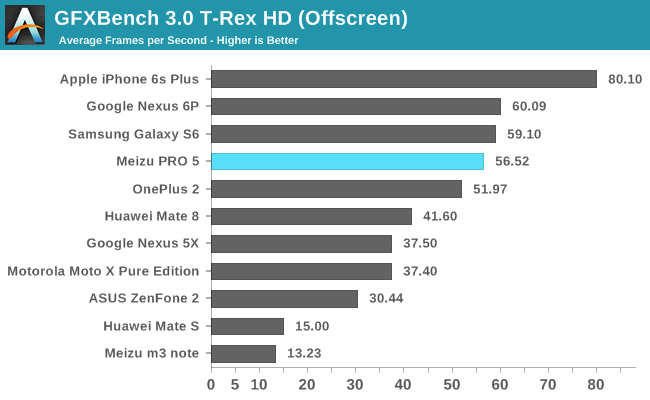
To better understand how the PRO 5 performs across a wide variety of games, we will start by looking at the OpenGL ES 2.0-based T-Rex game simulation. Because of its 1080p display, it has fewer pixels to process than the 1440p Galaxy S6, leading to better onscreen performance. Peak offscreen performance is also good, comparable to the Nexus 6P and its Adreno 430 GPU.
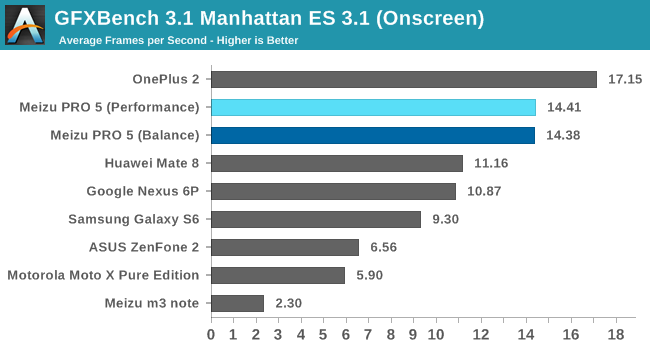
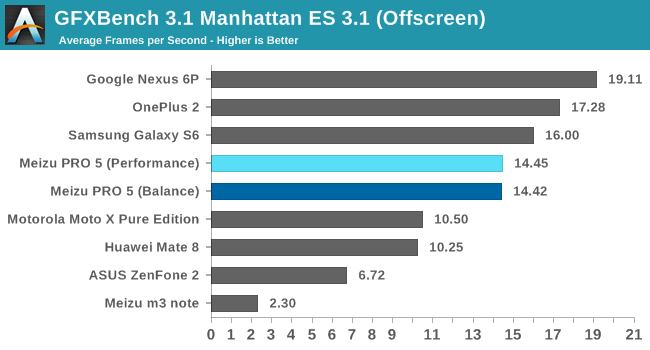
The GFXBench 4.0 Car Chase game simulation, which uses OpenGL ES 3.1 plus Android Extension Pack (AEP) features, is part of our normal test suite; however, the PRO 5 does not support hardware tessellation and is not able to run this test, so instead we’ll fall back to using GFXBench Manhattan 3.1, which still uses OpenGL ES 3.1 but does not use any AEP features.
Starting off, the PRO 5’s results are the same for both the Performance and Balance power modes. While the different modes will have some effect on performance for games that are more CPU bound, this test is entirely GPU limited, and because the PRO 5’s power modes do not affect GPU frequency, they have no impact in this test.
In the offscreen test, the PRO 5 is about 38% faster than the Moto X Pure Edition (Adreno 418) and the Mate 8, which uses the newer Mali-T880 GPU. While the Mali-T880 includes three ALU units per core versus two ALUs per core for the Mali-T760, the Mate 8 uses only four cores where the PRO 5 uses eight. After accounting for the difference in GPU clock frequency, this gives the PRO 5 124 GFLOPS of FP32 throughput versus 108 GFLOPS for the Mate 8. And because the PRO 5 has twice as many cores as the Mate 8, it can process twice as many texels/pixels per cycle too. This also applies to Huawei’s P9, whose Kirin 955 SoC uses the same Mali-T880MP4 GPU.
In the older GFXBench T-Rex test, the PRO 5’s performance was similar to the OnePlus 2 and Nexus 6P, which both use Qualcomm’s previous generation Adreno 430 GPU. This test, however, includes many more pixel effects, which take advantage of Adreno’s superior ALU performance, giving the Nexus 6P a 32% advantage over the PRO 5. While not shown in the charts above, phones such as the LG G5, which use the latest Snapdragon 820 SoC and its Adreno 530 GPU, are about twice as fast as the PRO 5 in this test.
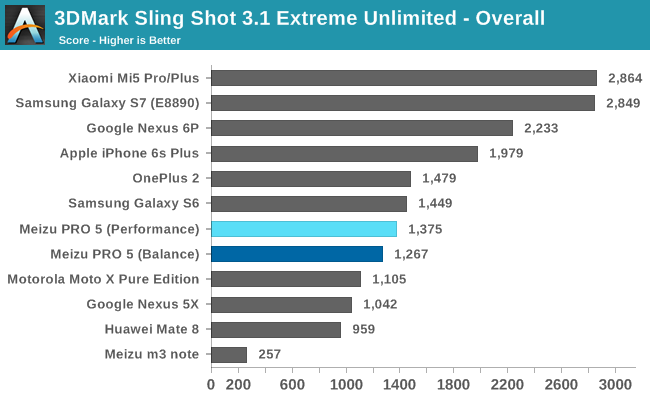
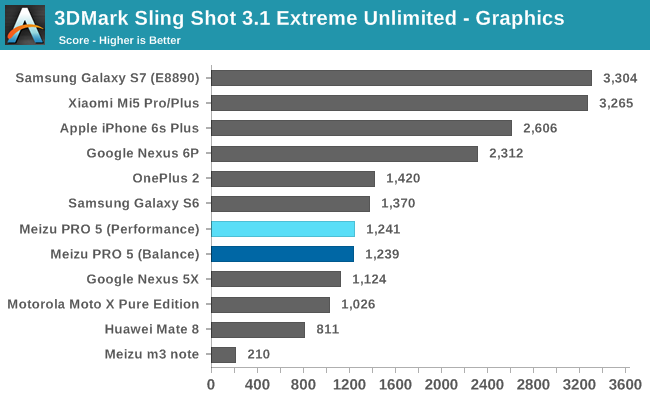
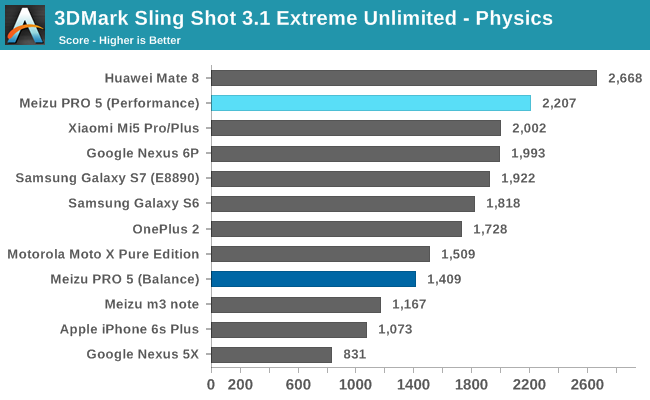
3DMark Sling Shot Extreme is another OpenGL ES 3.1 game simulation test that renders offscreen at a higher 1440p resolution than our other tests (the Physics test renders at 720p) and includes both GPU and CPU elements. Zeroing in on the graphics score, we see the PRO 5 outperform the phones using Adreno 418 and Mali-T880MP4 GPUs once again. The Nexus 6P and its Adreno 430 is 86% faster, however. The Xiaomi Mi5 (Adreno 530) and Galaxy S7 (Mali-T880MP12) perform about the same in this test with peak performance 2.66x higher than the PRO 5.
The Physics test measures CPU and memory performance by running an open source physics simulator. The PRO 5 and its Exynos 7420 SoC perform quite well, outperforming the newer Exynos 8890 and Snapdragon 820 SoCs in the Galaxy S7 and Xiaomi Mi5, respectively. Only the Mate 8’s Kirin 950 performs better. Because this is primarily a CPU test, we see a significant difference in performance between the PRO 5’s Performance and Balance modes, with the former showing a 57% advantage.
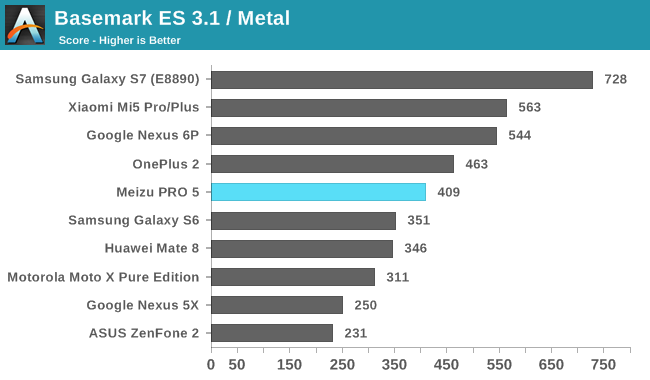
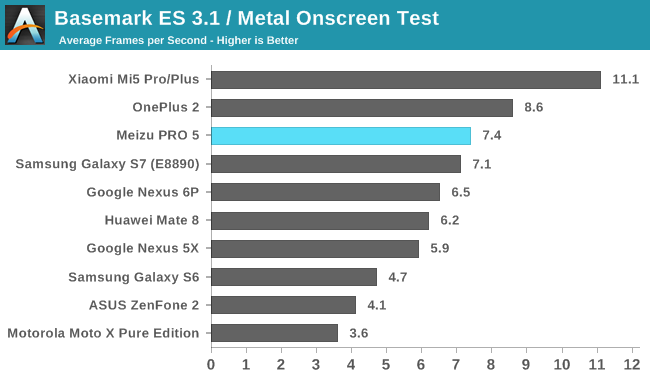
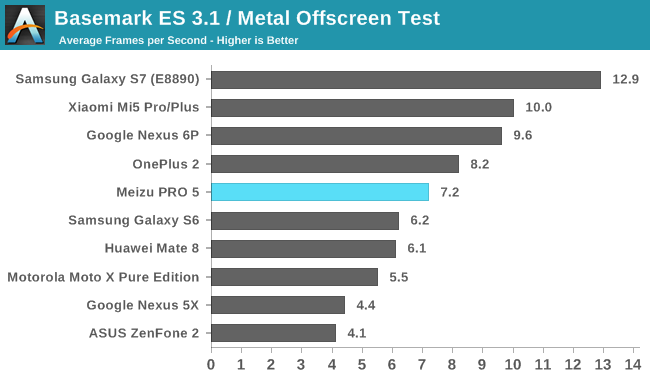
The previous performance trends hold true in Basemark ES 3.1. The Galaxy S7 at the top of the offscreen chart uses a Mali-T880MP12 GPU running at up to 650MHz. This gives it a peak, theoretical FP32 throughput of 234 GFLOPS, more than twice the Mate 8’s 108 GFLOPS and about 1.9x the PRO 5’s 124 GFLOPS, which is very close to the overall performance difference between the PRO 5 and Galaxy S7 (Exynos 8890).
The Meizu PRO 5 is certainly capable of playing modern games as long as they do not require hardware tessellation—its graphics driver currently does not support this feature. It cannot match the peak performance of the latest SoCs, but that level of performance is still overkill for the majority of games currently available. Its 1080p display, which is a negative mark overall, at least helps improve onscreen graphics performance.










80 Comments
View All Comments
Pissedoffyouth - Friday, June 24, 2016 - link
Could you perhaps do a review of the Xiaomi Redmi Note 3, Matt? This is a good reviewMatt Humrick - Friday, June 24, 2016 - link
I'm actually working on a dual review of the Xiaomi Redmi Note 3 and Meizu M3 note right now :)ETA-Asker - Saturday, June 25, 2016 - link
ETA on RN3 review pleaseMatt Humrick - Saturday, June 25, 2016 - link
I should be done with the review in about 2 weeks, but we have several phone reviews nearing completion, so I'm not sure where it will fit in the queue.Chillin1248 - Sunday, June 26, 2016 - link
I was literally about to push the buy button the RN3 till I saw this comment. I am eagerly awaiting the review to decide.Please check by the way regarding the camera issues and the overheating issues (especially while charging) that are going around the web. Thanks!
iBend - Sunday, July 10, 2016 - link
or just wait for RN4..its rumored to use SD652, but maybe its still 3-4 months away
zeeBomb - Friday, June 24, 2016 - link
HOLY CRAP! A MEIZU PRO5 REVIEW, A REVIEW I ASKED ANDREI MONTHS AGO!ANANDTECH DELIVERS!
leexgx - Tuesday, June 28, 2016 - link
4G is not 3G (DC-HSPA+ is not a new network) just mobile operators in the USA got there way to name it thatGuppy_ - Friday, June 24, 2016 - link
Wow, never thought i'd see a meizu pro 5 review on anandtech. heck I even joined just to comment!What made you decide to do the review?
Also, since the meizu is audio focused, how bout a comparison versus other smartphones in that same sense?
kspirit - Friday, June 24, 2016 - link
What's up with Chinese phone reviews being more frequent than those from other markets? No one reviewed the Moto phones, only one Sony phone was covered in any depth. AT stop, you're better than this bargain bin Chinese trash.